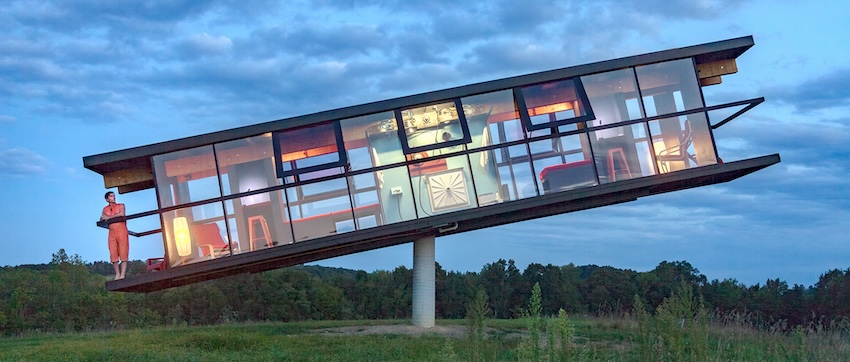Designed and built by Behaviour and Building Performance Group’s associate and artist Alex Schweder with Ward Shelley, ReActor is part of an experimental, performative series of ‘social relationship architecture’. In the summer of 2016, for a total of five days, the architect-artist duo lived in the rotating house, which is located in upstate New York.
 The focus of the BBP research group is on the interrelationships between people and the built environment.
The focus of the BBP research group is on the interrelationships between people and the built environment.
The BBP group is an interdisciplinary and collaborative research initiative working at intersection of:
- Behaviour (neuroarchitecture, people, practices, health, wellbeing, cognition, etc.)
- Built environment (urbanism, architecture, construction, simulation, modelling, etc.)
- Performance and Policy (environmental, energy, social, sustainability, etc.)
We believe that the human experience is influenced by the built environment (and vice versa) and that the performance and sustainability of the built environment is dependent on this interaction. Although the context for our research is global –with projects in Europe, Africa, Asia and beyond– it has a direct relevance to the UK. In England alone, more than 10 million people currently live in ‘non-decent’ homes that present a serious health, safety and environmental risk. From a neurological cognition perspective, our focus on 'neuroarchitecture' reveals how the built environment and cities impinge on our mental wellbeing. The solutions to such challenges are interdisciplinary and require the consideration of economic, engineering, environmental, and social factors in the design and retrofit of our built environment.
Our projects address the key sustainable development challenges of health and wellbeing (SDG3), gender equality (SDG5), clean and affordable energy (SDG7), sustainable cities (SDG11), responsible consumption and production (SDG12) and climate action (SDG13).
For example, MindScape is a multidisciplinary network based at Cambridge that is setting the research agenda at the intersection of wellbeing, education and architecture. For more information visit: https://www.crassh.cam.ac.uk/research/networks/mindscape/
| Co-directors: | Visiting Fellows: | |
|
Dr Chiara Jutzi (University of Salzburg, Austria) Tijn Croon (TU Delft, The Netherlands) Dr Philip Graham (Cullinan Studio, UK) Mette Boisen Lyhne (Aarhus School of Architecture, Denmark) |
||
| Researchers: | Associates: | |
|
Shujuan Chen Rebecca Forster Flora Haiwei Li Mengyuan Li T. Shao |
Dr Jamie Anderson (Buro Happold, UK) Dr Anna Boldina (Director, Green Button Design and Research) Dr Alex Coburn (University of California, San Francisco, USA) Dr Kan-chane Gunawardena (TU Delft, Department of Urbanism) Dr Yasser Khaldi (Arab American University, Palestine) Dr Rihab Khalid (Research Fellow, Lucy Cavendish College, Cambridge, UK) Dr Xin Li (Nanjing University, China) Dr Martijn Lugten (Assist. Prof., TU Delft, Netherlands) Dr Zhikai Peng (Assist. Prof., TU Delft, The Netherlands) Dr Maiss Razem (Al Ahliyya Amman University, Jordan) Dr Alex Schweder (Performance Architecture, New York, USA) Isabelle Sjövall (University College London, UK) Lydia Tew (Max Fordham LLP, Cambridge, UK)
|
Publications:
Please use the individual staff links in the list above to access CVs and publications.

